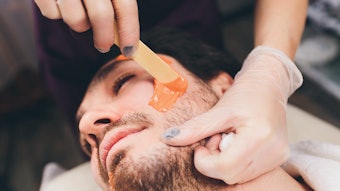
Editor’s note: This article is the second part of a three-part series about how cancer affects the skin. The first part appeared in the March 2012 issue, and addressed cancer and skin dehydration. The third part will appear in the May 2012 issue and will cover cancer’s impact on the skin’s appearance. Skin care professionals must seek specialized training before offering the services addressed in this series.
Robin was in her late 40s when diagnosed with ovarian cancer. Her initial symptoms were vague, and the cancer had spread by the time of diagnosis. Her medical treatment plan started with a biopsy, and was followed with chemotherapy and surgery. During and after the chemotherapy, Robin had profound sensory changes and lost all her hair. When describing her experience, she said: “It feels like hot marbles running up and down my head.”
Chemotherapy
Chemotherapy is a systemic cancer treatment used when cancer has spread or metastasized beyond the initial tumor, or there is a very high risk of metastasis. It refers to chemical agents or drugs that are selectively destructive to cancer cells. These drugs target cells to stop their growth and development, eventually stopping the growth, development and spread of the cancer. In Robin’s case, the cancer had spread beyond her ovaries, and into parts of her large bowel and liver before it was detected and treatment could commence.
Cancer cells reproduce largely uninhibited, and it is these cells multiplying that eventually form a tumor. At any time, cancerous cells can also break away from the original site and be carried in the blood to distant sites elsewhere in the body, setting up new cancerous growths. This is called metastasis, and it is a hallmark of cancer. Destruction and control of these sometimes-distant metastases require a treatment that also travels throughout the body, such as chemotherapy. Chemotherapy is usually given intravenously, but it also can be administered several other ways, including via a pill taken orally. It travels through the blood to reach all parts of the body. Chemotherapy works by interfering with cell reproduction. Cancer cells take the major hit because most are continuously reproducing.
There are a large number of chemotherapy agents that may be used alone or in combination in the treatment of cancer. The prescribed chemotherapy will depend on the type of cancer, its aggressiveness and the overall health of the patient. Although some types of chemotherapy are very targeted and specific, many others are very good at indiscriminately destroying cells that are reproducing. It is this more or less indiscriminate destruction of reproducing cells that leads to the side effects commonly associated with chemotherapy. The cells of the gastrointestinal tract, bone marrow and hair follicles normally reproduce often. Unfortunately, many chemotherapy agents are not smart enough to distinguish between the unwanted reproduction of cancer cells and the normal cells that are reproducing. This causes the side effects of nausea, vomiting, immune system suppression with infection and loss of hair. Robin suffered hair loss along with a less common side effect: peripheral neuropathy.
Peripheral neuropathy
Peripheral neuropathy is a condition in which the nerves outside the brain and spinal cord have been damaged, often by the cancer treatments themselves. This causes pain and other altered sensations. (See Symptoms of Peripheral Neuropathy.) Sometimes the symptoms are temporary and gradually improve after the treatment is completed, but sometimes the pain persists. Robin’s description of her experience, “hot marbles running up and down my head,” is especially vivid. Others describe difficulty walking because they cannot feel where their feet are touching down; problems holding a pen or buttoning a coat because of the loss of sensation; or experiencing pain when their hair falls out.
1. Initial assessment and analysis. When Robin arrived at Ahava Spa and Wellness Center in Toledo, Ohio, her skin was sensitive to the touch and to spa products; she was hurting. It is imperative that clients be assessed for exactly where they are in their treatments, and what they are experiencing. That is how you are best able to help and bring comfort.
2. Preparation and approach. A gentle approach was mandatory with Robin. Although estheticians love to take clients to that “special” place, which generally involves hot towels and massage, when they have sensory problems, it has to be looked at in a different way. Women receiving chemotherapy or radiation therapy can have trouble with their temperature gauges. Many times, they are warmer than normal. If you couple that with a recent hysterectomy or chemically induced menopause, then hot is not good.
Other measures to consider in preparation for the spa experience are using cotton linens and being careful of any crowding of the clients’ personal space. If hot does not help these clients, try working with teas. Soak either towels or gauze in tea while it cools to room temperature. Teas are rich in antioxidants, and these help calm painful sensations. (See Teas and Healing.)
Treatment
Robin’s spa treatment plan incorporated cooling elements, and avoided anything that was hot or that produced heat, such as massage oils or creams. The products used were organic and soothing. Highlights included the following.
- No steam was used.
- Eye pads were soaked in tea and cooled to less than room temperature.
- The exfoliant used was mild and natural.
- Cool towels soaked in teas were used to transition between each product.
- During the massage, a gel-form mask acting as a massage cream was applied at room temperature with cool water. Fingers were remoistened with cool water to allow for a nice glide.
- A gentler touch was used because of the client’s heightened sensitivity.
- A calming mask was applied at the end of the service to infuse the skin with essential nutrients.
- A finishing serum was applied for maximum skin support.
Evaluation and follow-up
Clients who are struggling with sensory problems during cancer treatment tend to not continue a skin care regimen at home. Often, they will say that they’re afraid it will only make their sensory issues worse. You, as an esthetician, are the skin care expert, and the one who knows skin health and nutrition. Help your clients make a plan for skin care at home. Following are several possible recommendations.
- Recommend teas to be used as compresses; use about a tablespoon of tea to a quart of water.
- Use gel serums instead of creams, oils or lotions.
- Think creatively to overcome any obstacles.
Improve their quality of life
When working with clients who suffer with cancer, perspective is critical. (See Is It Hard Working With Cancer Clients?) Chemotherapy often successfully destroys or controls cancer that has metastasized; however, its side effects can be overwhelming. Peripheral neuropathy and other skin-sensation changes negatively impact the quality of life of these clients. Cool, soothing spa treatments can help improve it, as was evidenced by a letter the spa received from Robin after her services that stated: “God bless you and your angel-wing hands.”
Patricia Ringos Beach is a nurse, speaker and author with advanced certification in oncology and palliative care. In Toledo, Ohio, she works as a patient navigator and clinical nurse specialist.
Katie Morgan-Lousky is the owner of Ahava Spa and Wellness Center in Toledo, Ohio. She also founded Cherished Friends of Ahava, a ministry where cancer patients can receive spa services with sensitivity to their vulnerability and special needs. The authors can be contacted at [email protected].










